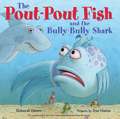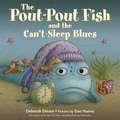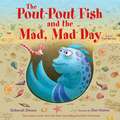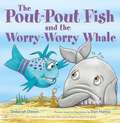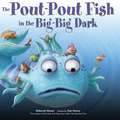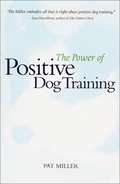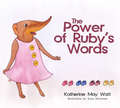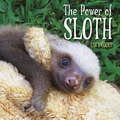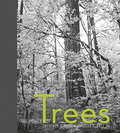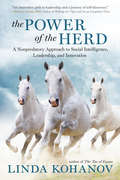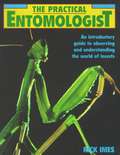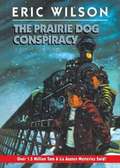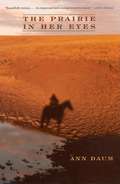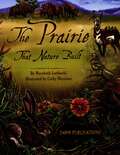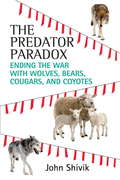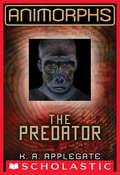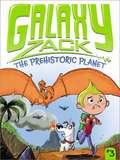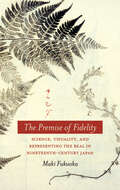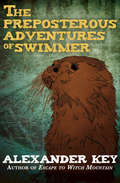- Table View
- List View
The Pout-Pout Fish and the Bully-Bully Shark (A Pout-Pout Fish Adventure)
by Deborah DiesenMr. Fish and all his friendsLove to play down at the park.But that ends when they’re bulliedBy a misbehaving shark!Mr. Fish wants to help.He knows bullying is wrong!But he’s just one fish—Is he really that strong?In The Pout-Pout Fish and the Bully-Bully Shark, the New York Times–bestselling Pout-Pout Fish teaches a bully shark about kindness and being a friend in this original picture book. Swim along as he discovers the strength of his community, and the power of his own voice.
The Pout-Pout Fish and the Can't-Sleep Blues (A Pout-Pout Fish Adventure)
by Deborah DiesenMr. Fish can't fall asleep in this new jacketed hardcover addition to Deborah Diesen and Dan Hanna's New York Times–bestselling Pout-Pout Fish series.One night in the ocean, the Pout-Pout Fish can't get to sleep! He's all ready for bed, but he just can't catch a snooze. When he asks his friends for advice, they're all sure they know what he should do—count sheep, use a pillow made of rocks, swim in circles—but nothing works. What to do when good advice isn't good for everyone? Little guppies will love The Pout-Pout Fish and the Can't-Sleep Blues, a bedtime story about learning from experience and doing what's best for you!
The Pout-Pout Fish and the Mad, Mad Day (A Pout-Pout Fish Adventure)
by Deborah DiesenThe New York Times-bestselling children's book series returns with The Pout-Pout Fish and the Mad, Mad Day.The Pout-Pout Fish's morning has been maddening and rough. Disappointments and frustrations—Mr. Fish has had enough! It's been one thing, then another, then another stacked on top. He's mad and getting madder. Is there any way to stop?Swim along with Mr. Fish as he faces his anger and gains new understandings. With a little help from his friends, he might just discover the healing power of words and self-compassion.
The Pout-Pout Fish and the Worry-Worry Whale (A Pout-Pout Fish Adventure)
by Deborah DiesenMr. Fish helps his friend Willa Whale overcome her social anxiety in the next installment of the New York Times–bestselling Pout-Pout Fish series from Deborah Diesen and Dan Hanna.Willa Whale is full of worries! Will the party be too loud?Will she find someone to talk to? Will she get lost in the crowd?Mr. Fish is Willa's friend, and he'd like to help her out.Can some of his suggestions help Willa with her doubt?Swim along with The Pout-Pout Fish and Willa Whale as they explore the world of worry. Together, they might just learn that when worry swims inside us, there are things that we can do!
The Pout-Pout Fish in the Big-Big Dark
by Deborah Diesen Dan HannaMr. Fish wants to help his friend Ms. Clam when she loses her pearl, but though he's fast as a sailfish, as smart as dolphin, and as strong as a shark, Mr. Fish has a secret: he's scared of the dark!Very young children will swim along with Mr. Fish as he journeys deep into the ocean to new and mysterious places. They will discover, as Mr. Fish does, the power of friendship to light the way through the big-big dark.
The Power of Lulu! (Pictureback(R))
by Rachel ChlebowskiMeet the DC Super-Pets in this full-color storybook—just in time for the DC League of Super-Pets movie to hit theaters in Summer 2022! Whenever the people . . . and pets! . . . of Metropolis are in danger, Krypto the Super-Dog flies in to save the day! Fans of the new hit film ages 3 to 6 will love meeting all the heroes and villains in this full-color storybook!
The Power of Positive Dog Training
by Pat MillerFrom the Book Jacket: UNLOCK THE POWER OF THE POSITIVE WITHIN YOU AND YOUR DOG TO ACHIEVE ALL YOUR TRAINING GOALS. Access your power! In this long-awaited book by one of the leading proponents of positive dog training, Pat Miller demonstrates how you can train your dog, have fun, and build a lasting relationship at the same time. Walk away from punishment-based training methods and learn how you can reward your dog to obtain and reinforce the behaviors you could only dream about achieving. Access your dog's power! When you apply Pat's Positive Training Principles and follow Pat's unique six-week training program, your dog will learn to think and to choose proper behavior. The Power of Positive Dog Training will transform you and your dog into an unbeatable team, capable of addressing any challenge you may encounter. Pat Miller has been a dog trainer for over 30 years. She is a leading proponent of positive dog training techniques, and her columns on training are regularly read by thousands in publications such as Whole Dog Journal. She sits on the Board of Directors of the Association of Pet Dog Trainers (APDT), an organization dedicated to the promotion of positive dog training. She also is the founder of Peaceable Paws Dog & Puppy Training (www.peaceablepaws.com).
The Power of Ruby's Words
by Susie Berryman Katherine May WattRuby is a Shrew and Muriel is a Marsupial Mouse and they are very good friends. They caught the bus to the beach and Muriel brought her happiness. Ruby did not! Muriel knows the secret. Can Ruby find the secret too?
The Power of Sloth
by Lucy CookeThe Power of Sloth is Lucy Cooke's celebration of the sloth: the cutest, cuddliest, slowest creature on this planet. In the book she brings together some truly adorable pictures of baby sloths, literally by the bucketful. These delightful, funny pictures are accompanied by a simple text which tells you all about sloths and why we should protect them. We also discover all about the work of the Avarios sloth sanctuary, which, along with the ZSL EDGE programme to protect the pygmy sloth, receives some of the proceeds from this book. This book has been a huge success in the USA, where is was published under the title of The Little Book of Sloth, selling over 50,000 copies and making the New York Times best-seller list.
The Power of Trees
by Charles Katz Gretchen DailyIntimate in size yet quietly breathtaking in scope, this graceful gift book will forever change how you think, and how you feel, about trees. In poetically sparse scientific observations, renowned conservation biologist Gretchen Daily narrates the evolution, impact, and natural wonder of trees. Alongside photographs by Chuck Katz, the text and images form a quiet and moving meditation on The Power of Trees. Twenty-six duotone black and white photographs illustrate the development of trees: how trunks were formed, what tree rings tell us about human societies, and how trees define the future of humanity. Pictures of trees threading through the landscape - dotting mountainsides, braiding along the sides of glassine rivers - bear witness to the lyrical force and clarity of Daily's observations.Recreating the authors' hike together through the landscape of the Skagit River in Washington State, the balletic movement between Daily's commentary and Katz's vision reaches out to readers, inviting them to enjoy the landscape through a scientific understanding of trees. At once emotional and intellectual, The Power of Trees is the first collection of nature photographs that invites the reader to not only delight in the gorgeous play between light and shadow, but also the fascinating natural mechanisms that create such striking natural beauty.An ecologist by training, Gretchen Daily is an internationally acclaimed conservancy advocate and scholar. Her role as a National Trustee for The Nature Conservancy will feature prominently in the national marketing campaign to bridge the gap between scientific educators and the general nature reader.
The Power of Trees
by Charles Katz Gretchen DailyIntimate in size yet quietly breathtaking in scope, this graceful gift book will forever change how you think, and how you feel, about trees. In poetically sparse scientific observations, renowned conservation biologist Gretchen Daily narrates the evolution, impact, and natural wonder of trees. Alongside photographs by Chuck Katz, the text and images form a quiet and moving meditation on The Power of Trees. Twenty-six duotone black and white photographs illustrate the development of trees: how trunks were formed, what tree rings tell us about human societies, and how trees define the future of humanity. Pictures of trees threading through the landscape - dotting mountainsides, braiding along the sides of glassine rivers - bear witness to the lyrical force and clarity of Daily's observations.Recreating the authors' hike together through the landscape of the Skagit River in Washington State, the balletic movement between Daily's commentary and Katz's vision reaches out to readers, inviting them to enjoy the landscape through a scientific understanding of trees. At once emotional and intellectual, The Power of Trees is the first collection of nature photographs that invites the reader to not only delight in the gorgeous play between light and shadow, but also the fascinating natural mechanisms that create such striking natural beauty.An ecologist by training, Gretchen Daily is an internationally acclaimed conservancy advocate and scholar. Her role as a National Trustee for The Nature Conservancy will feature prominently in the national marketing campaign to bridge the gap between scientific educators and the general nature reader.
The Power of Trees
by Charles Katz Gretchen DailyIntimate in size yet quietly breathtaking in scope, this graceful gift book will forever change how you think, and how you feel, about trees. In poetically sparse scientific observations, renowned conservation biologist Gretchen Daily narrates the evolution, impact, and natural wonder of trees. Alongside photographs by Chuck Katz, the text and images form a quiet and moving meditation on The Power of Trees. Twenty-six duotone black and white photographs illustrate the development of trees: how trunks were formed, what tree rings tell us about human societies, and how trees define the future of humanity. Pictures of trees threading through the landscape - dotting mountainsides, braiding along the sides of glassine rivers - bear witness to the lyrical force and clarity of Daily's observations.Recreating the authors' hike together through the landscape of the Skagit River in Washington State, the balletic movement between Daily's commentary and Katz's vision reaches out to readers, inviting them to enjoy the landscape through a scientific understanding of trees. At once emotional and intellectual, The Power of Trees is the first collection of nature photographs that invites the reader to not only delight in the gorgeous play between light and shadow, but also the fascinating natural mechanisms that create such striking natural beauty.An ecologist by training, Gretchen Daily is an internationally acclaimed conservancy advocate and scholar. Her role as a National Trustee for The Nature Conservancy will feature prominently in the national marketing campaign to bridge the gap between scientific educators and the general nature reader.
The Power of the Herd: A Nonpredatory Approach to Social Intelligence, Leadership, and Innovation
by Linda KohanovLinda Kohanov is beloved for her groundbreaking articulation of “the way of the horse,” an experiential wisdom known to riders for centuries but little studied or adapted to off-horse use. Now Kohanov takes those horse-inspired insights on the nonverbal elements of exceptional communication and leadership into the realms of our workplaces and relationships. Here we explore the benefits of “nonpredatory power” in developing assertiveness, fostering creativity, dealing with conflict, and heightening mind-body awareness. In “A Brief History of Power,” the first part of this far-reaching book, Kohanov profiles cultural innovators who employed extraordinary nonverbal leadership skills to change history, usually on horseback: Winston Churchill, George Washington, Alexander the Great, and Siddhartha Gautama (the Buddha), among others. She also draws on the behavior of mature horse herds, as well as the herding cultures of Africa and Mongolia, to debunk theories of dominance hierarchies, challenge ingrained notions of “survival of the fittest,” and demonstrate the power of a consensual leadership in which governing roles are fluid. Kohanov then adapts these lessons into twelve powerful guiding principles we can all incorporate into our work and personal lives. Eloquent and provocative, this is horse sense for everyone who seeks to thrive in the herds we all run in — our communities, careers, families, and friendships.
The Practical Entomologist
by Rick Imes<p>From exploring the basic principles of entomology to starting a collection, The Practical Entomologist is the perfect introduction to the world of insects. <p>Beginning with the basics, the text describes what characterizes an insect, including anatomy and the life cycle. It takes an order-by-order look at insects, explaining how each group differs from another and why certain types of insects have been classified together. The book shows you not only what to look for but how and where to look for it -- from capturing and keeping live insects to ways of making a collection and taking photographs. <p>Tips on keeping a field notebook are also included. Packed with more than 200 full-color illustrations, this comprehensive guide is a valuable reference tool for nature enthusiasts.</p>
The Prairie Dog Conspiracy (Tom and Liz Austen Mystery #12)
by Eric WilsonDuring a long cold winter in his home town, young Tom Austen stumbles across some strange activity in an abandoned house.
The Prairie Dog Town (Animal Life Stories)
by Don Arthur TorgersenMeet prairie dogs in this science based story. Find out how they build their homes, what animals are their friends or enemies, what they eat, how they grow up, how they spend their days and nights and much more.
The Prairie in Her Eyes (The World as Home)
by Ann DaumFraming her recollections with the passage of cranes over her South Dakota ranch, Daum writes about the difficulties of living in a remote place--a fickle river, rattlesnakes, hospitals too far away to be much use, social isolation--but also what keeps her there--the cranes, the rhythms of the land & seasons, her horses, the bonds of family. Unflinching and understated, Daum breaks the silence that for too long has marked (and marred) the lives of western women. Her essays start in the present (she raises sport horses on a piece of what was a 13,000 acre spread) and cycle back through her childhood, with stories about her father, blizzards, a coyote, the White River that whipsaws their land, the differences between people, and the artifacts left by others who have tried to scrape a living out of the land. With humor and insight, her essays touch on different aspects of rural life and convey her vision for a good life in the west.
The Prairie that Nature Built
by Marybeth LorbieckiNature on the prairie, including both wildlife and wildfire, is a rich and closely knit ecosystem, as reflected in the interlocking verses of this simple story. Endnotes present facts, activities, related games, and resources
The Predator Paradox
by John ShivikAn expert in wildlife management tells the stories of those who are finding new ways for humans and mammalian predators to coexist. Stories of backyard bears and cat-eating coyotes are becoming increasingly common--even for people living in non-rural areas. Farmers anxious to protect their sheep from wolves aren't the only ones concerned: suburbanites and city dwellers are also having more unwanted run-ins with mammalian predators. And that might not be a bad thing. After all, our government has been at war with wildlife since 1914, and the death toll has been tremendous: federal agents kill a combined ninety thousand wolves, bears, coyotes, and cougars every year, often with dubious biological effectiveness. Only recently have these species begun to recover. Given improved scientific understanding and methods, can we continue to slow the slaughter and allow populations of mammalian predators to resume their positions as keystone species? As carnivore populations increase, however, their proximity to people, pets, and livestock leads to more conflict, and we are once again left to negotiate the uneasy terrain between elimination and conservation. In The Predator Paradox, veteran wildlife management expert John Shivik argues that we can end the war while still preserving and protecting these key species as fundamental components of healthy ecosystems. By reducing almost sole reliance on broad scale "death from above" tactics and by incorporating nonlethal approaches to managing wildlife--from electrified flagging to motion-sensor lights--we can dismantle the paradox, have both people and predators on the landscape, and ensure the long-term survival of both. As the boundary between human and animal habitat blurs, preventing human-wildlife conflict depends as much on changing animal behavior as on changing our own perceptions, attitudes, and actions. To that end, Shivik focuses on the facts, mollifies fears, and presents a variety of tools and tactics for consideration. Blending the science of the wild with entertaining and dramatic storytelling, Shivik's clear-eyed pragmatism allows him to appeal to both sides of the debate, while arguing for the possibility of coexistence: between ranchers and environmentalists, wildlife managers and animal-welfare activists, and humans and animals.
The Predator: The Predator (Animorphs #5)
by K. A. ApplegateThe wildly popular books by K.A. Applegate are back! The Animorphs return in this update of the classic series.Marco never wanted to be an Animorph. He didn't want the ability to change into any animal he touches. And he certainly didn't want to be one of a handful of kids that are the planet's only defense against a secret alien army. His friends know why he feels the way he does. He's worried about his dad -- the only family Marco has left. If anything happens to him, his father will be alone. But something big is about to change for Marco. Something that could finally give him a reason to fight.
The Prehistoric Planet
by Ray O'Ryan Colin JackGalaxy Zack blasts back to the past in this outer space chapter book adventure!A baby pterosaur can't find his way home, so it's up to the Nebulon Navigators to return him to the Prehistoric Planet. And when Zack's dad is invited on the journey, Zack finds a way to go along too! But as they blast off on the super shuttle, they hear a strange noise. Is it the pterosaur, crying for his mama? No, it's...Zack's dog, Luna, who has snuck onto the shuttle! When the shuttle lands, Zack can't believe his eyes: The Prehistoric Planet is full of creatures that he's only read about in books. Zack and the team of navigators head out in search of the pterosaur's mother--and end up in the middle of an amazing adventure. With easy-to-read language and illustrations on almost every page, the Galaxy Zack chapter books are perfect for beginning readers.
The Prehistoric Planet
by Ray O'Ryan Colin JackGalaxy Zack blasts back to the past in this outer space chapter book adventure!A baby pterosaur can't find his way home, so it's up to the Nebulon Navigators to return him to the Prehistoric Planet. And when Zack's dad is invited on the journey, Zack finds a way to go along too! But as they blast off on the super shuttle, they hear a strange noise. Is it the pterosaur, crying for his mama? No, it's...Zack's dog, Luna, who has snuck onto the shuttle! When the shuttle lands, Zack can't believe his eyes: The Prehistoric Planet is full of creatures that he's only read about in books. Zack and the team of navigators head out in search of the pterosaur's mother--and end up in the middle of an amazing adventure. With easy-to-read language and illustrations on almost every page, the Galaxy Zack chapter books are perfect for beginning readers.
The Premise of Fidelity: Science, Visuality, and Representing the Real in Nineteenth-century Japan
by Maki FukuokaThe Premise of Fidelityputs forward a new history of Japanese visuality through an examination of the discourses and practices surrounding the nineteenth century transposition of "the real" in the decades before photography was introduced. This intellectual history is informed by a careful examination of a network of local scholars-from physicians to farmers to bureaucrats-known as Shohyaku-sha. In their archival materials, these scholars used the termshashin(which would, years later, come to signify "photography" in Japanese) in a wide variety of medical, botanical, and pictorial practices. These scholars pursued questions of the relationship between what they observed and what they believed they knew, in the process investigating scientific ideas and practices by obsessively naming and classifying, and then rendering through highly accurate illustration, the objects of their study. This book is an exploration of the process by which the Shohyaku-sha shaped the concept of shashin. As such, it disrupts the dominant narratives of photography, art, and science in Japan, providing a prehistory of Japanese photography that requires the accepted history of the discipline to be rewritten.
The Preposterous Adventures of Swimmer
by Alexander KeyAfter years in captivity, a brilliant otter escapes into the wildGrowing up in the high country, Swimmer bathed in clean water and dined on fresh crawfish. Then the trapper came, killing Swimmer&’s mother and imprisoning him and his sister, who did not survive. After years of being poked and prodded by the Professor, he has had enough. He slips out of the townhouse and into the park across the street but is forced to return home when the city water proves too filthy to swim in. Unable to proceed on his own, he does something he vowed never to do: He asks the caretaker, Clarence, for help. Convinced that Swimmer would die in the wild, Clarence refuses to help the otter break free. And so, when the Professor is on a trip to Nashville for a lecture, Swimmer takes his chance, escaping back into the high country. It&’s a wild world out there, and this clever otter intends to conquer it all.
The Preposterous Adventures of Swimmer
by Alexander KeyAfter years in captivity, a brilliant otter escapes into the wildGrowing up in the high country, Swimmer bathed in clean water and dined on fresh crawfish. Then the trapper came, killing Swimmer&’s mother and imprisoning him and his sister, who did not survive. After years of being poked and prodded by the Professor, he has had enough. He slips out of the townhouse and into the park across the street but is forced to return home when the city water proves too filthy to swim in. Unable to proceed on his own, he does something he vowed never to do: He asks the caretaker, Clarence, for help. Convinced that Swimmer would die in the wild, Clarence refuses to help the otter break free. And so, when the Professor is on a trip to Nashville for a lecture, Swimmer takes his chance, escaping back into the high country. It&’s a wild world out there, and this clever otter intends to conquer it all.
